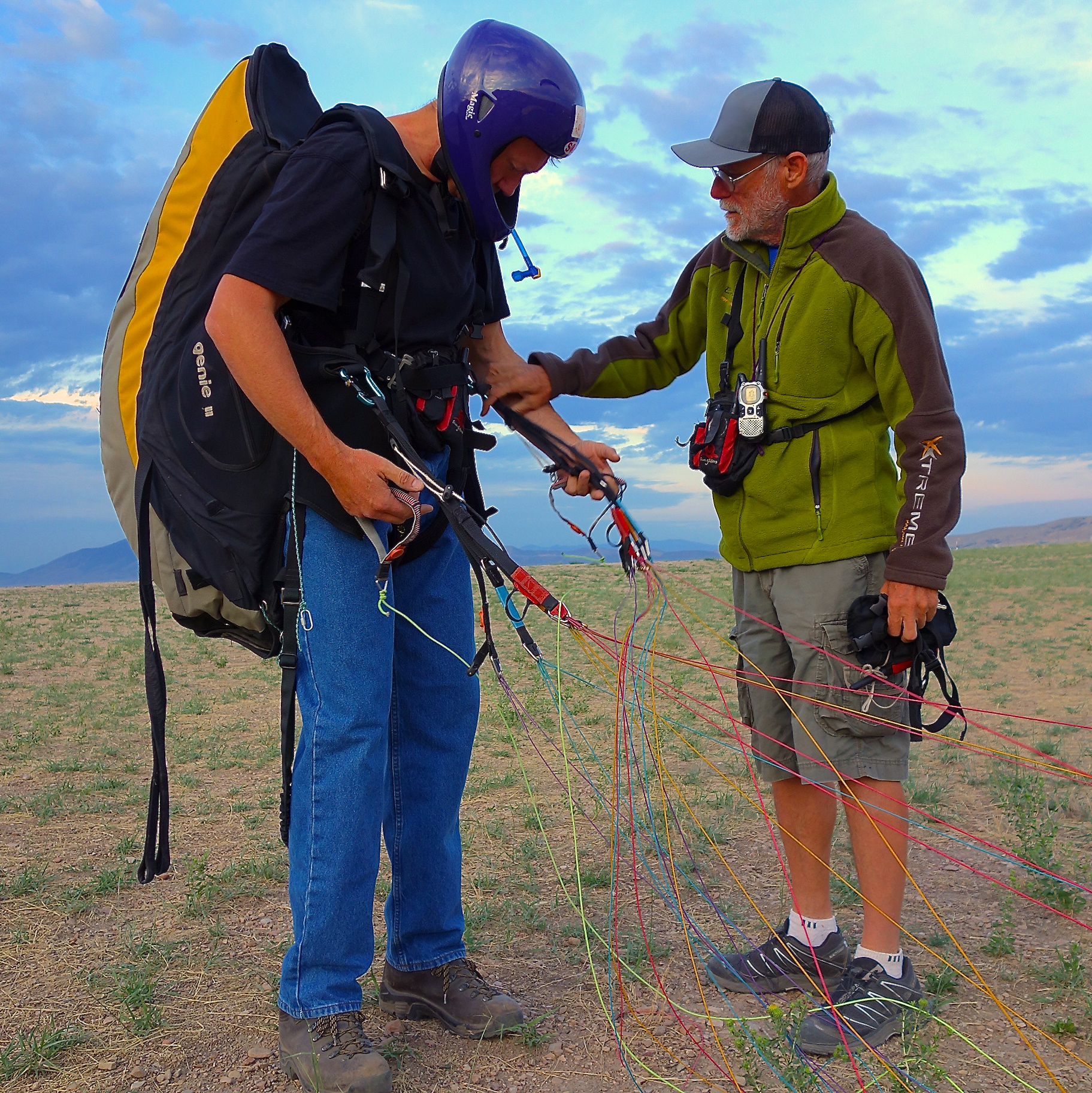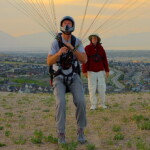Description
What is an Introductory Paragliding Lesson?
It is the important first step in the process of becoming a paraglider pilot. Students will be introduced to safety procedures, essential paragliding gear, and basic paragliding concepts that will be used to help get them off of the ground and into the air that very first day. Lessons are given at the Point of the Mountain in Draper, Utah by Ken Hudonjorgensen, which is recognized as the top paragliding training site in the United States. Introductory lessons are always subject to current local weather conditions, and dependent on the student’s natural skill ability, comprehension capacity, physical endurance limitations, confidence level, overall attitude, and their degree of focused effort. But most certainly many more times than not, beginning low-level flight is indeed successfully experienced by first time student pilots during their introductory paragliding lesson. And in so doing, they will gain a strong sense of what paragliding is all about, and effectively be well on their way to wherever they may ultimately wish to fly.
What can you expect during an Introductory Paragliding Lesson?
The lesson is a solo hands-on experience, and not a tandem flight. Student training takes place only during the first 3 to 4 hours of daylight on any given day, which is the most predictable, consistent, and therefore safest time of day for learning. Each student will receive a detailed briefing concerning the objectives and goals for the lesson. Equipment used will be thoroughly explained and discussed, and students will always be in radio contact with the instructor while in the air and when landing.
Your first attempt to fly will start near the bottom of a hill. From there, you’ll run down the remaining slope of that hill trying to inflate your glider above your head, which will give you your first opportunity to begin learning how to control it. That initial effort generally does not result in any flight time. But then you’ll turn right back around and hike back up that hill, only this time you’ll climb up a bit higher. Then, you’ll run as fast as you can down that hill again to cause enough drag to inflate your wing (glider) above your head as you go. And with that second attempt, your chances are pretty darn good that you’ll get at least 1 to 10 feet off of the ground.
Then it’s back up the hill again, even higher. And then away you go again, catching air and inflating your wing in the wind with the speed that you generate running full speed until you’re suddenly magically lifted into the air. Perhaps with that try you’ll get 20 or more feet off of the ground, while simultaneously lengthening your overall flight distance as well. And then as you’ve probably guessed by now, with each successive attempt thereafter, you’ll climb higher and higher up that hill. And with each gallant effort that you give to skillfully control your paraglider to carry your body up into the sky, you will inevitably continually increase your overall flight height, time, and distance.
It’s important to understand though, that paragliding is a weather dependent sport. And because safety at Two-Can Fly Paragliding is always of principle and paramount concern, lessons may or may not last four hours, and may or may not result in any flight time at all. Winds control everything. But with favorable conditions and your successful application of learned paragliding finesse, you’ll more than likely pass your first paragliding lesson with flying colors.



Your review is awaiting approval
? ????????? ?????? ??????? ????? ?????????? ?????? ? ??????????? ?? ???????? ?????? ????? ??? ?? ???? 09.06.2025!
?????? ???? ????????? ?????? ??? ????? ?? KRAK?N : https://krashop.ru
??????????? ????????? ?????? ? ????, ??? ??? ????????? ????????? ???????!
1) ??????????? ?????? (????? ?? ?????????? ? ???????? ????E?): https://krashop.ru
2) ??????????? ??????o ?????H:
https://krashop.ru
3) ????????? ??????o ?????H:
https://kro33.cc/
4) ???????? ??????, ???? ?????? ?? ???????? (? ?????????????? VPN):
https://krashop.ru
5) ???:
https://kro33.cc/
??? ????????? ????????????, ??????? ??????? ??? ?????? ? ????????? ??????? ?? ???? ??????:
1. ???????? TOR ???????
??? ??????? ? ???????-????????, ??????? ??????, ??? ??????????? ??????????? ???????, ?????????????? Onion-?????. ????? ?????????? ??????? ???????? Tor ???????. ??? ??? ??? ??????????:
????????? ?? o?????????? ???? Tor ???????.
???????? ???????????? ???? ??? ????? ???????????? ???????.
?????????? ???????, ?????? ??????????? ?? ??????.
2. ????????? Tor ???????
????? ????????? ???????? Tor ???????. ?? ????????????? ?????? ??????? ??????????? ? ???? Tor, ??? ????? ?????? ????????? ?????. ????????? ?????????? ???????????.
3. ????????? ?? ?????????? ??????
https://kro33.cc
??????????? ?????????? ?????? ??? ??????? ? ????? ??????: ???????? ??? ?????? ? ???????? ?????? Tor ???????? ? ??????? Enter. ??? ???????????? ??? ?? ??????? ???????? ????????????.
4. ???????? ??????? ??????
???? ? ??? ??? ??? ???????? ?? ???????, ??? ????? ????? ??????????????????. ??????? ??????????? ???????? ????????? ????:
?? ??????? ???????? ??????? ??????? ?????? “???????????” ? ??????? ?? ???.
????????? ????? ???????????, ?????? ??????????? ??????????, ????? ??? ?????, ?????? ? ????? ??????????? ?????.
??????????? ???????? ?????? ? ???????? ????????????? ?????????????? ??? ?????????????? ????????????.
5. ????????????????? ?? ?????
????? ??????????? ??????? ? ???? ?????? ???????, ????????? ????????? ??? ??????????? ????? ? ??????. ?????????, ??? ?? ??????????? ?????? ?????????? ?????? ? ??????????? ????????? ??? ??????? ? ???????.
???? ???????????? ??? ????????????? ????????
????????? ???????-??????????????, ????? ????????? ???? ????????????????. ??? ????????? ???????, ??????? ??????? ??? ??????????? ????:
?????????? ??????!
???????-????? ????? ?????? ???? ?????? ??-?? ??????????? ????????????. ????????? ?????????? ?????????? ?????? ?? ??????? ? ??????????? ??????????, ????? ???? ?????????? ? ???????????? ???????????? ??????.
??????????? VPN!
??? ?????????????? ??????????? ? ???????????? ????????????? ???????????? VPN-??????. ?? ?????? ??? IP-????? ? ??????? ???? ?????????? ? ????????? ????? ??????????.
?????? ?????????!
https://kro33.cc/ – ?? ???? ????!
?????? ????
?????? ??????????? ????
?????? ???? kr2connect co
?????? ???? ???????
?????? ?? ???? ??????
?????? ??????? ?????
?????? ???? ???????
???? ?????? ???
?????? ??????? ????
?????? ???? ???????????
??? ????? ?? ???? ??????
???? ?????? kraken
?????? ???? ??????
?????????? ???? ???????
?????? ???? ????????
?????? ???? kr2web in
?????? ??????????? ???? ??????
?????? ?? ???? ??????
?????? ??????? ?????
?????? ??????????? ????
???? ?????? ???
?????? ???? ?? ????
?????? ???? ??????? ???????
?????? ??????? ????
?????? ???? ???????
?????? ???? ??????
???? ??????
??? ????? ?? ???? ??????
?????? ?????? ?? ????
?????? ???? kr2web. in
?????? ???? ???????
??? ????? ?????? ????
?????? ??????? ?????? ?????? ?? ???? ???
???? ?????? ?????? ???
?????? ???? ?????? ???
?????? ???? ??????????? ??????
kraken ??????? ?????? onion
kraken ?????? vk
?????? ???? ?????? kraken 11
?????? ?? ?????? kraken 9 one
kraken ??????? ??? kraken2web com
?????? ????? ?????? kraken one com
?????? kraken 2 kma biz
?????? ?? kraken ???????? ????????
razer kraken ????
kraken ??????? krakenweb one
kraken ??????? krakenweb3 com
kraken ??????? ?????? ?????? krakenweb one
kraken ?????? ??????? krakenweb one
kraken darknet market ?????? ??? 2kraken click
kraken ?????? krakenweb one
kraken ?????? ??? krakendarknet top
kraken casino ??????? kraken casino xyz
kraken darknet market ??????? v5tor cfd
kraken ???? ??????? kraken2web com
kraken ??????? ??????
kraken ??????? kr2web in
kraken ??????? store
kraken darknet market ?????? ??? v5tor cfd
kraken darknet market ????
??????? ??????????? ???? kraken
kraken ?????? ??????? ??????? kraken2web com
kraken ??????? ??? ?????? kraken2web com
kraken ??????????? ???????
kraken ??????????? ??????? k2tor online
kraken darknet ?????? ?????? ?????? market
kra33.cc
kraken 6 at ???? ?????????????
???? ?????? kraken darknet top
kr?33.cc
kraken ???? ??????